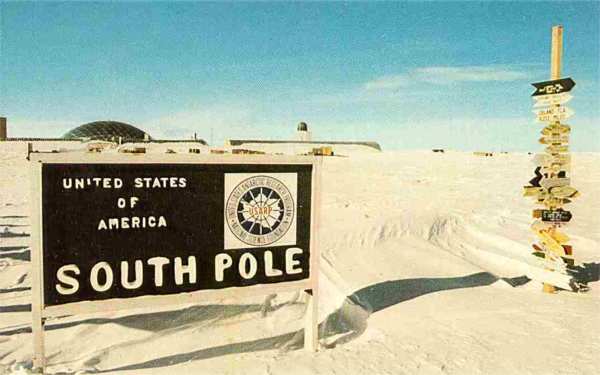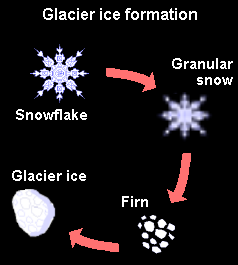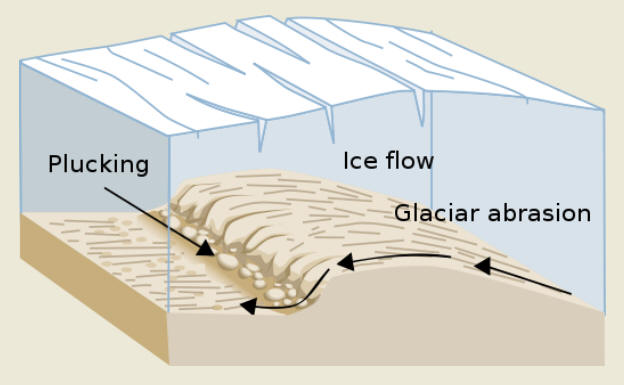Growth
- Accumulation: Glaciers form in any area where there is more snow fall than snow melt on average year after year. In prolonged “ice house” periods (Ice Ages), snow fall accumulates, much like sediment settling out of water. As this sediment accumulates it compacts and condenses, forming a mass of ice that can be thousands and thousands of feet (the Antarctic Ice Sheet is home to the thickest ice in the world, just shy of 3 miles thick).
- Firnification: Snow falls as pointed tessalations. Their accumulate in loose assemblages with tons of empty air space between their points. Even at sub-freezing temperatures, ice on the snowflake points sublimates and then freeze out again, filling in the pits of the flakes. As this process repeats, eventually all those flakes form little balls. This process can be sped up if the snowflakes are mechanically broken down by wind or compression.
- Glacier Ice: Pressure lowers the melting point of ice and the increased weight of snow accumulation both squeezes out air space from the ice and can melt ice into liquid water. This can refreeze, “gluing” the firn together into glacier ice. We’ve started with light fluffy snow and are left with a solid chunk of dense, air-free ice.
Movement

The pole marking the South Pole is now several kilometers away from the actual South Pole due to glacial movement (Postcard from 1980, photo by James E. Payne)
- Basal slip: There are two types of glaciers: valley glaciers and continental glaciers. Valley glaciers are situated in valleys that slope downward. In this setting, gravity plays a role in pulling ice down along this slope. As it’s pulled it moves in fits and starts, between a few millimeters to tens of meters in a single day!! While the glacier scours and reshapes the valley, movement is constrained by the walls of the valley.
- Plastic flow: At a certain point, a glacier might expand to the point where it is no longer constrained by the valley itself. The topography of the land is obscured by the enormity of the ice. The movement of these continental glaciers – called ice fields when small, ice sheets when large – is not controlled by gravity so much as by the weight of the glacier itself in the zone of accumulation. Think something along the lines of pressing your hand down onto a ball of cookie dough, which pushes out the dough at the margins. As long as their is a positive budget (more accumulation than melting), the glacier continues to advance. During the last ice age, the glaciers were pushed as far south as Long Island by this motion. Because these glaciers move over the tops of mountains they tend to round and soften the landscape.
Erosion
The key to remember here is that glaciers are actually moving. It’s not that snow just piles up at the margins, but that the weight from the accumulation of snow pushes the glacier outwards at its margins. As the ice moves it reshapes the landscape through erosion by:
- Freeze-thaw weathering: Ice melts under the weight of the glacier, filling in cracks in the rock underneath. When this ice refreezes it expands, fracturing off chunks of rock from the bedrock.
- Plucking: These freeze-thaw weathered rocks are then plucked up from the bedrock by the movement of ice and become entrained in the glacier.
- Transportation: Rocks entrained in the glacier range in size from tiny silt and clay sediments up to giant glacial erratics (like Big Rock up in Alberta, which weighs 36,400,000 pounds). As the glacier flows, so too does the material scoured from the landscape.
- Abrasion: As these materials are pulled along with the flowing glacier, the material on the bottom of the glacier acts like sandpaper, scouring and abrading the bedrock
- Deposition: Some of the material is pasted and then packed down in extremely dense mats of unsorted material (known as till to the geologist, hardpan to the farmer). sediments are deposited as the glaciers melted and liquid water transports and sorts the materials downstream.
With a brief sketch of how a glacier moves we can begin to piece together what glaciers leave behind as evidence that they were once here in Vermont. As we do that, I’ll draw out in greater detail the processes of erosion, examining the results of all that ice scouring, grinding, scratching, abrading, crumbling and shaping bedrock.
As I’m not a glaciologist, check out this video by Smarter Every Day:






